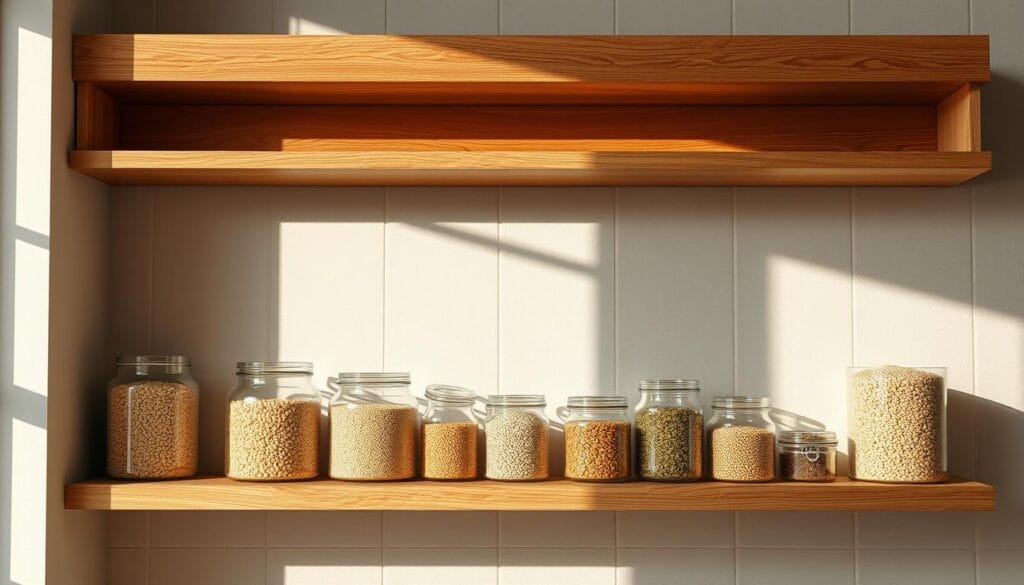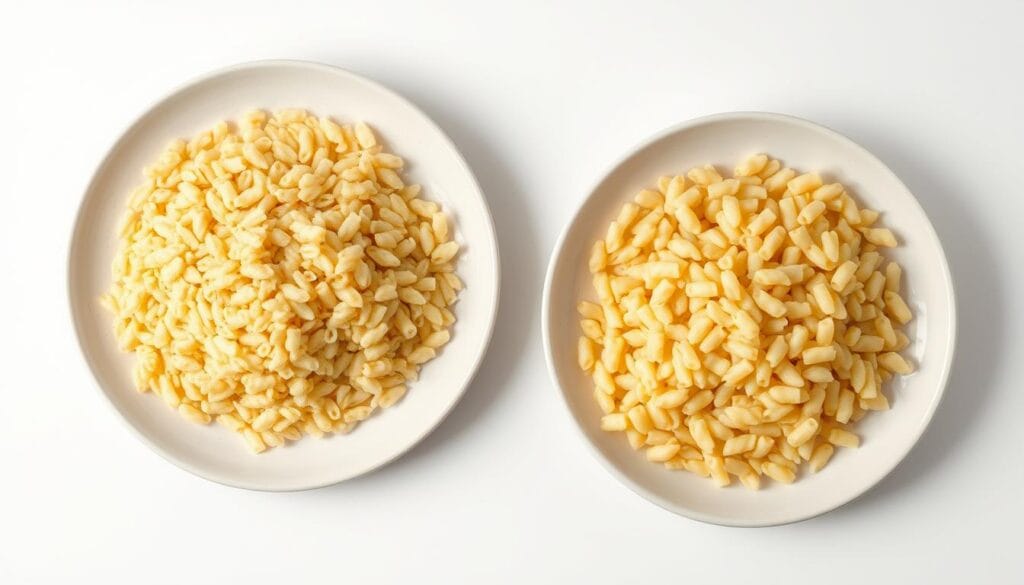Making perfect gluten-free orzo at home is all about using the right ingredients and techniques. You can make delicious orzo dishes with gluten-free flours and the right cooking methods. Gluten-free orzo can be made from ingredients like quinoa, corn, rice, and chickpeas. For example, DeLallo Gluten-Free Orzo is made from Non-GMO corn and rice.
Gluten-free orzo is perfect for those with gluten intolerance or Celiac disease. It cooks up like traditional pasta, with a nice al dente bite. As more people deal with gluten issues, the demand for gluten-free pasta has grown. You can use gluten-free orzo in salads, soups, and casseroles.
Gluten-free pasta, like orzo noodles, must have a certified gluten-free seal. This ensures they are safe for those with gluten intolerance. By using quality ingredients and the right techniques, you can make perfect gluten-free orzo at home. In this article, we’ll show you how to do it, including the essential ingredients, kitchen tools, and cooking methods.
Key Takeaways
- Gluten-free orzo can be made from various ingredients, including quinoa, corn, rice, and chickpeas.
- The right combination of gluten-free flours and proper cooking methods is essential for making perfect gluten-free orzo.
- Gluten-free orzo is a great option for those with gluten intolerance or Celiac disease.
- Gluten-free pasta products must carry a certified gluten-free seal to indicate they meet safety standards for gluten-free consumption.
- DeLallo Gluten-Free Orzo is a high-quality option made with a blend of Non-GMO corn and rice.
- Gluten-free orzo can be used to make a variety of dishes, including salads, soups, and casseroles.
Understanding Gluten Free Orzo
Gluten free orzo is a pasta made from grains like rice, corn, or cassava. It’s perfect for those who can’t eat gluten. You can use it in salads, soups, and more. It’s a key ingredient in many gluten-free recipes.
Unlike traditional orzo, gluten free orzo tastes and feels similar. DeLallo Gluten-Free Orzo, for instance, is 70% Non-GMO corn and 30% rice. It’s made in a dedicated gluten-free facility to avoid cross-contamination.
Benefits of Gluten Free Orzo
Gluten free orzo is great for many dishes, like soups and salads. It’s also packed with carbs, protein, and fiber. This makes it a healthy choice for a gluten-free diet.
Gluten Free Orzo Options
Many brands offer gluten free orzo, like DeLallo and Banza. They use rice, corn, or cassava. You can also make your own gluten free orzo at home with gluten-free grains and a pasta maker.
| Brand | Ingredients | Gluten Free Certification |
|---|---|---|
| DeLallo | 70% Non-GMO corn, 30% rice | Yes |
| Banza | Chickpea flour, rice flour, corn flour | Yes |
Essential Ingredients for Homemade Gluten Free Orzo
For gluten free cooking, the right ingredients are key. To make homemade gluten-free orzo, you’ll need gluten-free flours like rice, corn, or cassava. These flours are the base of gluten free pantry essentials and can be used in many dishes.
You’ll also need eggs, water, and salt for the orzo. The type and mix of flours can change the orzo’s texture and taste. Try different combinations to find what works best. Adding olive oil, garlic, and herbs can also improve the flavor and texture.
Here’s what you need for homemade gluten-free orzo:
* Gluten-free flours (like rice, corn, or cassava)
* Eggs
* Water
* Salt
* Olive oil
* Garlic
* Herbs (such as basil or oregano)
With these ingredients, you can make delicious homemade gluten-free orzo. It’s great for many dishes.
Required Kitchen Equipment and Tools
To start making your gluten-free orzo, you’ll need some essential kitchen equipment and tools. Having the right tools makes the process easier and more efficient. It’s important to have a well-stocked pantry with gluten free pantry essentials for gluten free cooking.
Here are the basic equipment needs:
- Stand mixer: for mixing and kneading the dough
- Pasta machine: for rolling out the dough to the right thickness
- Cutting tool: for cutting the orzo into the right shape and size
Basic Equipment Needs
There are also some optional tools that can help. These include a pastry brush, a cleaning brush, and a drying rack.
Optional Helpful Tools
Setting up your workspace is also crucial. Make sure you have a clean and flat surface to work on. Also, have all your equipment and tools within reach.
Setting Up Your Workspace
Preparing Your Gluten Free Flour Blend
Mixing different gluten free grains is key to making a great flour blend. The right mix can change how your gluten free orzo tastes and feels. Try using quinoa, corn, rice, and chickpeas to find your perfect blend.
Some people like a mix of 70% Non-GMO corn and 30% rice, like DeLallo Gluten-Free Orzo. For those who can’t have gluten, certified gluten-free orzo is a good choice. Always make your blend in a place free from gluten to avoid contamination.
Here’s a simple recipe to start with:
- 2 cups of gluten free corn flour
- 1 cup of gluten free rice flour
- 1/2 cup of gluten free quinoa flour
You can tweak this recipe to fit your taste and recipe needs. Always choose fresh, quality gluten free grains for the best taste and texture.
Exploring different gluten free flour blends and recipes can lead to amazing orzo dishes. Whether it’s for a soup or salad, gluten free grains and recipes can make your meal delicious and fulfilling.
Step-by-Step Gluten Free Orzo Making Process
To make delicious gluten free orzo, follow a few simple steps. First, make the dough. Then, shape the orzo and dry it to remove excess moisture. This makes perfect gluten free pasta, just like traditional wheat pasta.
When making gluten free orzo, use a mix of gluten-free flours like rice and corn. You can buy a pre-mixed blend or mix your own. The goal is to find a mix that tastes great and works well for you.
- Mix and knead the gluten-free flour blend with eggs and water to create a smooth dough.
- Shape the dough into small pieces, similar to barley or a grain of rice, to create the orzo shape.
- Dry the orzo using a dehydrator or by air-drying it to remove excess moisture.
By following these steps, you can make delicious gluten free orzo. It’s perfect for soups, salads, and pasta dishes. Cook it until it’s al dente, as the package says. With practice, you’ll make gluten free orzo like a pro. Enjoy the benefits of gluten free pasta in your favorite recipes.
Tips for Perfect Texture and Consistency
Gluten-free cooking can be tricky, especially when it comes to texture and consistency. To make healthy pasta alternatives like gluten-free orzo, use the right flour mix and avoid overmixing. This keeps the orzo from becoming tough and dense.
Cooking the orzo al dente is key. It should still have a bit of bite or chew. This makes the orzo hold its shape and texture, making it a great healthy pasta alternative to traditional orzo.
Here are some additional tips to help you achieve the perfect texture and consistency:
- Use a combination of gluten-free flours, such as rice flour, quinoa flour, and corn flour, to create a well-balanced flavor and texture.
- Don’t overcook the orzo, as this can make it mushy and unappetizing.
- Experiment with different cooking liquids, such as chicken or vegetable broth, to add flavor and moisture to the orzo.
By following these tips and using the right ingredients, you can create delicious and healthy pasta alternatives that are perfect for gluten free cooking. Whether you’re making a simple orzo salad or a hearty orzo soup, the key to success lies in achieving the perfect texture and consistency.
| Ingredient | Quantity |
|---|---|
| Gluten-free orzo | 1 ½ cups |
| Chicken broth | 3 cups |
| Olive oil | 2 tablespoons |
Common Mistakes to Avoid When Making Gluten Free Orzo
When making gluten free orzo, it’s key to know common mistakes. These can change the texture and taste of your dish. Avoid overmixing the dough to prevent a tough texture. Also, don’t cook the orzo too short, or it will be crunchy. And, keep it away from humid places to stop it from getting soggy and tasting bad.
Some common mistakes to watch out for include:
- Overmixing the dough, which can lead to a dense texture
- Not cooking the orzo long enough, resulting in an undercooked texture
- Storing the orzo in a humid environment, which can cause sogginess and off-flavors
By avoiding these mistakes, you can make delicious gluten free orzo. It’s great for many gluten free recipes. Whether it’s a simple salad or a hearty dish with chicken and veggies, the right techniques matter a lot.
With practice and patience, you’ll get better at making gluten free orzo. You’ll enjoy a variety of tasty and healthy gluten free recipes and orzo dishes.
Cooking Your Homemade Gluten Free Orzo
To cook your homemade gluten free orzo, boil it in water or broth until it’s al dente. The cooking time can change based on the gluten-free flour type and desired texture. You can use chicken or vegetable broth to add flavor.
Stir the orzo occasionally while cooking to prevent it from sticking. Adding oil or butter to the water can also help. Use 4-6 cups of water for every 1 cup of orzo.
There are several ways to cook gluten free orzo, like boiling, steaming, or sautéing. You can also add it to soups, stews, or casseroles. For example, try a gluten free orzo salad with roasted veggies, olive oil, and lemon juice.
To get the right texture, don’t overcook your gluten free orzo. Check if it’s done by biting into a piece; it should be slightly firm. With these tips, you’ll soon master cooking gluten free orzo. Enjoy your delicious gluten free meals with your homemade pantry essentials.
Storage and Preservation Methods
Storing and preserving homemade gluten free orzo is key. To keep your gluten free grains fresh, proper storage is crucial. Store your gluten free orzo in an airtight container to maintain freshness.
For short-term storage, keep your gluten free orzo in a cool, dry place. This helps preserve its texture and flavor. For longer storage, freezing is a good option. Freezing extends the shelf life of your gluten free recipes.
Here are some tips for storing and preserving your gluten free orzo:
- Store your gluten free orzo in an airtight container to maintain freshness.
- Keep your gluten free orzo in a cool, dry place for short-term storage.
- Consider freezing your gluten free orzo for long-term storage.

By following these tips, you can enjoy your homemade gluten free orzo for longer. Your gluten free recipes will stay fresh and delicious.
Delicious Recipes Using Your Homemade Orzo
Now that you’ve made your own gluten-free orzo, it’s time to explore tasty recipes. Orzo dishes are versatile, perfect for salads, soups, stir-fries, and more. You can make a variety of meals with your homemade orzo.
One easy way to enjoy your homemade orzo is in salads. Mix it with your favorite veggies, proteins, and dressings for a quick meal. Try a Mediterranean salad with orzo, tomatoes, cucumbers, and feta cheese. Or, make a hearty salad with grilled chicken, avocado, and citrus vinaigrette.
Orzo also adds texture and flavor to soups. It’s great in vegetable soups or creamy broths. Stir-fries are another excellent choice, combining orzo with veggies and proteins for a fast dinner.
- Orzo and vegetable stir-fry with tofu and soy sauce
- Orzo salad with grilled chicken, cherry tomatoes, and balsamic vinaigrette
- Orzo and lentil soup with spinach and lemon juice
- Orzo and shrimp stir-fry with garlic and ginger
These are just a few ideas for using your homemade orzo. Its mild flavor and versatile texture make it a great choice for many dishes. Orzo is a healthy pasta alternative for a wide range of meals.
Nutritional Benefits of Gluten Free Orzo
Gluten free cooking requires careful choice of ingredients. Gluten free orzo, made from corn and rice, is a great option. It’s perfect for making tasty, healthy meals that fit your diet.
Gluten free orzo is packed with protein, fiber, and vitamins. These nutrients boost digestion, muscle health, and overall well-being.
Protein Content
Gluten free orzo is a good protein source. It has about 4-5 grams per serving. This helps muscles and keeps you full.
Fiber Benefits
It’s also full of fiber, both soluble and insoluble. This fiber is good for digestion, blood sugar, and weight control.
Vitamin and Mineral Profile
Gluten free orzo is rich in iron, B vitamins, and manganese. These are key for healthy blood, nerves, and bones.
Adding gluten free orzo to your meals can greatly improve your health. It’s a great choice for anyone looking to boost their diet with protein, fiber, and vitamins.
Comparing Homemade vs. Store-Bought Options
Choosing between homemade and store-bought orzo is important for gluten-free recipes. Homemade orzo lets you use fresh ingredients and control the taste and texture. Store-bought orzo might have preservatives and additives.
Looking at nutrition, some store-bought brands like San Remo and Barilla have similar calories and protein. But, they differ in sodium. San Remo has 30mg of sodium per 100g, while Barilla has just 5mg. Liguori has fewer calories and no sodium at all.

Whether to make homemade or buy orzo depends on what you value most. Homemade orzo offers customization and control over ingredients. But, if you prefer convenience and affordability, store-bought is a good choice. Think about ingredients, texture, and taste to decide what’s best for you.
Troubleshooting Your Gluten Free Orzo Recipe
Gluten free cooking can sometimes need a little fixing. You might find issues with texture, cooking time, or flavor. But, these problems can be fixed with a few tweaks. First, check your gluten free pantry to make sure you have everything you need.
Texture problems with gluten free orzo are common. You can fix this by changing the flour mix or adding xanthan gum. For instance, adding a bit of xanthan gum to your flour blend might help your orzo’s texture.
Common Issues and Solutions
- Cooking issues: Adjust the cooking time or temperature to achieve the perfect texture.
- Flavor adjustments: Add herbs and spices or change the type of broth used to enhance the flavor of your gluten free orzo.
- Texture problems: Adjust the ratio of flours or add xanthan gum to improve the texture of your gluten free orzo.
By following these tips, you can make your gluten free orzo recipe perfect. Enjoy delicious, homemade gluten free pasta dishes. Always use gluten free pantry essentials and adjust your recipe as needed for the best results.
Seasonal Variations and Flavor Additions
Gluten free recipes, like orzo dishes, are great for trying new things. You can add fresh herbs and spices to make your orzo taste bright and refreshing. For example, a sprinkle of basil or oregano can really make your orzo stand out.
Changing the broth can also add depth and richness to your orzo. This is especially helpful in gluten free recipes. You can use chicken, beef, or vegetable stock to enhance the flavor.
Adding different proteins and vegetables can also make your orzo more interesting. This adds texture and flavor contrast. You can try chicken, shrimp, bell peppers, and onions for a tasty mix.
Here are some ideas for seasonal variations and flavor additions:
* Spring: Add fresh asparagus and lemon to your orzo for a bright and refreshing flavor.
* Summer: Include grilled vegetables and herbs in your orzo for a smoky and savory flavor.
* Fall: Add roasted vegetables and nuts to your orzo for a warm and comforting flavor.
* Winter: Include hearty meats and root vegetables in your orzo for a rich and satisfying flavor.
Conclusion
Making perfect gluten-free orzo at home takes patience and practice. It also means being open to trying new things. This pasta can make your meals better, whether it’s a comforting risotto or a fresh pasta salad.
The fun is in the journey, not just the end result. Try different flavors and don’t worry about mistakes. With each try, you’ll get better and find new ways to use this versatile pasta. Enjoy your culinary adventures!
FAQ
What is the difference between traditional orzo and gluten-free orzo?
What are the essential ingredients for making homemade gluten-free orzo?
What kind of kitchen equipment and tools are needed to make gluten-free orzo at home?
How do you prepare a gluten-free flour blend for making orzo?
What are the steps involved in making gluten-free orzo from scratch?
What tips can help achieve the perfect texture and consistency of gluten-free orzo?
What common mistakes should be avoided when making gluten-free orzo?
How do you cook homemade gluten-free orzo?
How do you store and preserve homemade gluten-free orzo?
What are some delicious recipes that can be made with homemade gluten-free orzo?
What are the nutritional benefits of gluten-free orzo?
How does homemade gluten-free orzo compare to store-bought options?
How can you troubleshoot a gluten-free orzo recipe?
What are some seasonal variations and flavor additions for gluten-free orzo?
Table of Contents
Did you like this recipe?
There are no reviews yet. Be the first one to write one.

